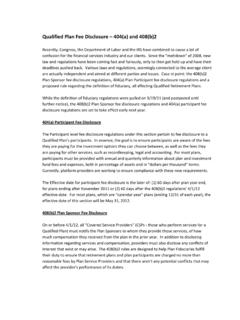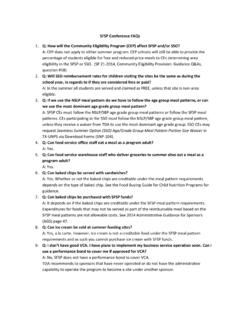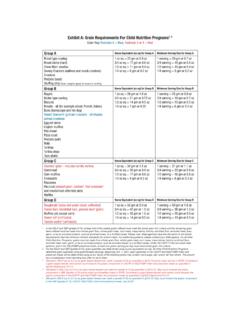Transcription of Child Nutrition Programs - Second Harvest Food Bank
1 Child Nutrition Programs Households with children are far more likely to be food insecure ( percent) than households without children ( percent).i Nearly 16 million American children are at risk of hunger. ii While hunger affects people of all ages, it is particularly devastating for children, for whom the repercussions of poor Nutrition and hunger are more severe. Over one in five children in the United States lives in a food insecure household and as a result may be more likely to experience the followingiii: Greater learning and academic difficulties Greater amounts of school absenteeism and tardiness Poorer general health and higher probability of hospitalization Federal Child Nutrition Programs reduce Child hunger and promote good Nutrition . Programs like the Special Supplemental Nutrition Program for Women, Infants and Children (WIC); school breakfast and lunch Programs ; and preschool, summer and afterschool meal Programs are vital in providing low- income children the food they need for healthy development and in improving their long-term health and educational outcomes.
2 WHO QUALIFIES. Individual Child Nutrition Programs have their own eligibility rules, but in general, Child Nutrition Programs serve children whose families have income at or below 185 percent of the federal poverty guideline ($36,611 for a household of 3 in 2014). Children in households with income below 130 percent of the poverty line qualify for greater benefits ($25,727 for a household of 3 in 2014). iv IMPROVE COGNITIVE AND PHYSICAL HEALTH AND DEVELOPMENT. Children regardless of income have different nutritional needs to support their physical and cognitive growth. Food insecure children struggle to thrive academically and physically. Undernourished children 0-3 years of age cannot learn as much, as fast or as well because their condition changes the fundamental architecture of the brain and central nervous vi Lack of enough nutritious food impairs a Child 's ability to concentrate and perform well in They have trouble focusing in school and are times as likely to repeat a grade. viii Six- to 11-year-old children who regularly do not get enough food to eat have significantly lower math scores and were more likely to repeat a grade.
3 Ix By contrast, children who eat breakfast score better on tests, show improved learning skills and memory retention, and have lower rates of tardiness and Updated May 2014. Food insecure children are also more likely to get sick and are 30 percent more likely to have a history of hospitalization. xi Iron deficiency and iron deficiency anemia (IDA), are the most prevalent nutritional deficiencies in the United Iron deficiency in early life has been linked to persistent deficits in cognition, attention, and behavior, even after treatment. Food insecurity has also been associated with low birth weight deliveries, which have a long-term impact upon infant health and growth Low birth weight is associated with lower IQ at age 18, and a 10 percent increase in birth weight increases a Child 's odds of graduating from high school. xiv By protecting against hunger and improving Nutrition , Child Nutrition Programs improve children's health and educational outcomes. PROVIDE Nutrition TAILORED FOR CHILDREN'S HEALTH.
4 Child Nutrition Programs in school, Child care, summer, and afterschool settings have nutritional requirements for meals and snacks. Nutrition standards and meal patterns are based on the latest Dietary Guidelines for Americans. While meals and snacks must meet federal Nutrition requirements, decisions about what specific foods to serve and how they are prepared are made locally. The NSLP is required to provide one-third of the daily calorie, protein, calcium, iron, vitamin A, and vitamin E needs for participants through foods provided at lunch. Meals served through the SFSP must include a serving of milk, two servings of fruits and/or vegetables, a serving of grains, and a serving of protein. A January 2012 USDA study rated the NSLP meal plan at on the Healthy Eating Index (HEI), significantly higher than the HEI score of for the average American Child 's The report further found that the CACFP meal plan received a score of , also higher than the average American diet score of xvi WIC provides a monthly food package designed to supply the nutrients typically lacking in the diets of the target population.
5 WIC also administers Nutrition counseling on healthy eating. The WIC food package was recently updated to align with the 2005 Dietary Guidelines for Americans, based on recommendations by the National Academies' Institute of Medicine. LEVERAGE PUBLIC-PRIVATE INFRASTRUCTURE. While lunch and breakfast are provided primarily through public schools, private schools also operate these Programs . Additionally, CACFP Programs reach children through private day care centers and Child care homes. Summer and after school Programs are also reliant upon a private network of infrastructure and staff to reach vulnerable children. Feeding America food banks sponsor both summer and afterschool Programs , working in partnership with local churches, boys and girls clubs, and other agencies. In addition to relying on federal funding through SFSP and CACFP to provide meals and snacks, many food banks also leverage private funding to operate these Programs and expand their reach. HOW Programs WORK. The Special Supplemental Nutrition Program for Women, Infants and Children (WIC) safeguards the health of low-income women, infants, and children up to age 5 who are at nutritional risk.
6 The program provides monthly packages of nutritious foods, information on healthy eating, and referrals to health care. WIC food packages are designed to supply the nutrients typically lacking in the diets of the target population. Eligibility is limited to families with incomes up to 185 percent of the poverty level. WIC is not an entitlement program it can only serve as many people as it has funding available. Funding is set each year through the annual appropriations process. The National School Lunch Program (NSLP) and School Breakfast Program (SBP) operate in public and private schools, providing nutritionally balanced meals each school day. Schools receive a cash reimbursement for each lunch or snack served. Schools also receive USDA commodity food donations for lunches. Low-income children are eligible for reduced-price or free lunches and snacks. Children in households with incomes below 130 percent of the poverty level or those receiving SNAP or TANF qualify for free meals, and those with family incomes between 130 and 185 percent of the poverty line qualify for reduced-price meals.
7 NSLP is an entitlement program that guarantees a set reimbursement for each qualifying meal or snack served. The Summer Food Service Program (SFSP) provides free meals and snacks to low-income children during the summer months and long school vacations. SFSP may be operated by schools, government agencies, summer camps, day camps, churches, or community organizations. SFSP meals and snacks are provided free to eligible children. Children qualify if they are eligible for free or reduced-price meals which must be certified through the application and enrollment process. However, if a site is located in a high-poverty area one in which at least 50 percent of area children qualify for free or reduced-price meals all children at that site are eligible. SFSP sites receive a cash reimbursement for each meal or snack served to qualifying children. SFSP is an entitlement program that guarantees a set reimbursement for each qualifying meal or snack served. The Child and Adult Care Food Program (CACFP) provides healthy meals to preschool children in day care centers and Child care homes at a free or reduced-price.
8 CACFP also provides free meals to homeless children residing in eligible emergency shelters. CACFP's At-Risk Afterschool Care Program provides free snacks to low-income children in afterschool supervised educational or enrichment activities. Afterschool Programs may be operated by schools, churches, local parks and recreation departments, and other community organizations. Programs must be located in areas where at least 50 percent of children are eligible for free or reduced-price meals. CACFP Programs receive a cash reimbursement for each meal or snack served. USDA also makes commodity foods available to institutions participating in CACFP. CACFP is an entitlement program that guarantees a set reimbursement for each qualifying meal or snack served. PROGRAM ACCESS AND PARTICIPATION. Child Nutrition Programs could do far more to reduce hunger simply by reaching a greater number of kids. Of the more than million schoolchildren who received food assistance at lunch in the 2012-2013 school year a little over half received breakfast assistance ( million) and only 16 percent accessed a summer feeding program on a typical summer day.
9 Xvii Similarly, 62. percent of Feeding America client households with children under the age of 18 reported participating in the National School Lunch Program, but only 14 percent reported having a Child participate in a summer feeding Over 83 percent of eligible infants participate in WIC, compared to 54 percent of eligible children ages one to four. xix Many eligible children lack access to Programs simply because a program is not offered in their community. Over 100,000 schools operate the NSLP, but only 89,000 operate the SBP and just 42,700. SFSP sites operate nationwide. xx Some children face other barriers to participation, whether transportation is limited or eligibility provisions lack coordination with other agencies. Finally, not all eligible children enroll in the Programs , whether because of burdensome application procedures, social stigma, or other barriers to participation. Feeding America supports policies that increase the number of breakfast, summer, and afterschool sites and that explore alternative ways to connect hungry children with food during the summer.
10 In particular, we support SFSP demonstration projects, which are currently being implemented around the country to test innovative program delivery models to better reach children during the summer. Congress should also support policies that simplify eligibility determination and enrollment to make it easier for children to participate in the Programs and decrease stigma. Finally, we must take steps to provide children not just with enough food, but the right food, supporting policies that support and strengthen the strong commitment to Nutrition in Child Nutrition Programs and WIC. POLICY ASKS. Support timely implementation of the Healthy, Hunger-Free Kids Act of 2010. Fully fund WIC to serve all eligible women, infants, and children and provide $30 million for summer food demonstrative projects in FY2015 Appropriations Improve children's access to food during out-of-school times like after school, over the weekend, and during the summer when Congress reauthorizes Child Nutrition Programs in 2015.




